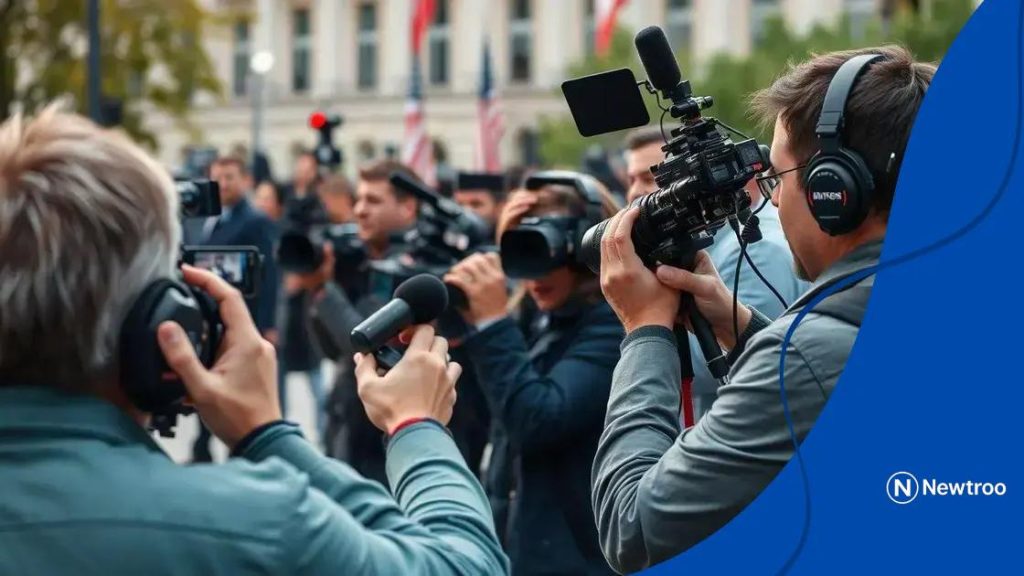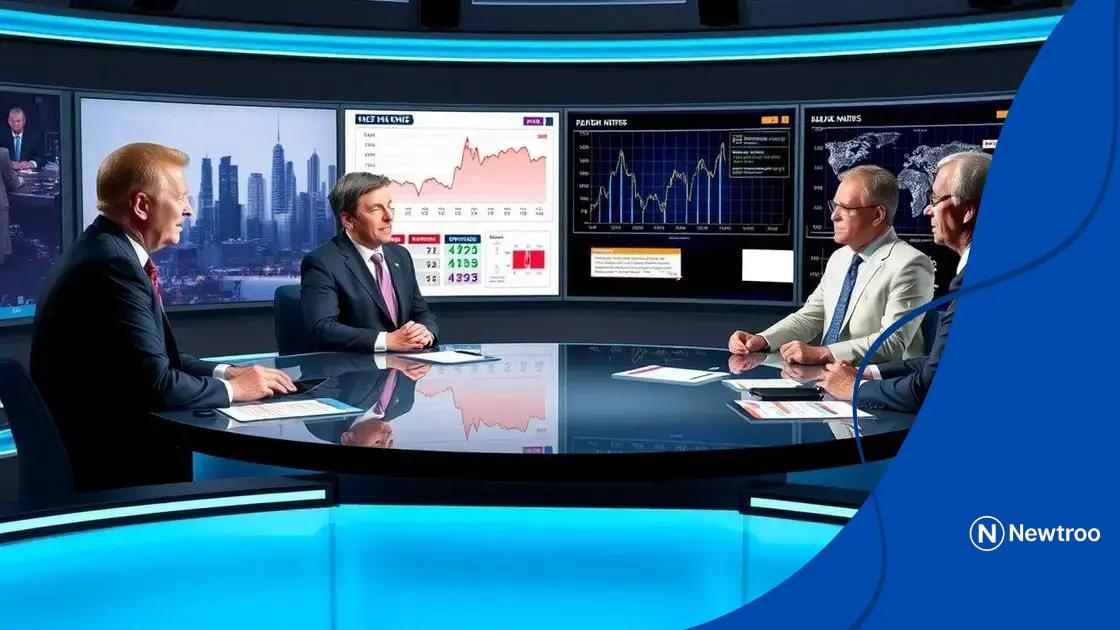PBS News Hour covers May 26 events that shape lives

Anúncios
PBS News Hour covers the May 26 events by providing timely updates, expert analyses, and insight into public reactions, highlighting the importance of informed discussion and the impact of these stories on communities.
PBS News Hour covers May 26 events that stirred conversations nationwide. Have you wondered how these stories shaped our views? Let’s dive into the details.
Anúncios
Key highlights from the May 26 events
The May 26 events showcased a range of significant occurrences that captured public attention. From local news stories to international developments, each event played a role in shaping current discussions.
One big feature was the unveiling of new policies by government officials. These policies aimed to address pressing community needs and sparked debate among citizens. For instance, the new educational reforms are designed to improve teaching standards and student resources.
Major announcements
Several high-profile announcements drew notable media coverage. These included:
Anúncios
- The launch of a public health initiative aiming to improve community wellness.
- Economic measures aimed at stimulating job growth in affected regions.
- Updates on environmental regulations to protect natural resources.
Additionally, insights from experts shed light on the implications of these decisions. They highlighted potential benefits and challenges, making it clear that public engagement is essential for success.
As news outlets reported on these topics, social media platforms buzzed with discussions, indicating a strong public interest. The May 26 events not only informed but also engaged citizens in vital conversations about their futures.
Impacts of significant occurrences
The impacts of significant occurrences can be profound and widespread. When major events happen, they often affect communities and even entire nations. Understanding these impacts helps us grasp the importance of these events.
One notable impact of recent occurrences has been on public opinion. For example, when new policies are announced, they can lead to divided viewpoints among citizens. Some might support the changes, believing they will improve society, while others may feel concerned about potential drawbacks.
Economic impacts
In addition to social changes, significant events can lead to economic shifts. Key areas affected include:
- Job creation in emerging sectors tied to new policies.
- Market responses, as investors react to news.
- Changes in consumer behavior based on public sentiment.
As these events unfold, local businesses may benefit or struggle depending on the public’s reception. For instance, a community health initiative might boost demand for certain medical services, while creating opportunities for new businesses.
Moreover, the emotional impact cannot be overlooked. Events that resonate with people can lead to increased activism or community solidarity. People often come together to support each other, showing strength amid change. This sense of unity faces both challenges and opportunities as public discussions continue.
Expert opinions on the covered events

Gathering expert opinions on the covered events brings a deeper understanding of their implications. Experts from various fields, including politics, economics, and social sciences, provide insights that help contextualize the news.
Many experts have pointed out that the context surrounding these events is crucial. Understanding the historical background allows the public to see why certain reactions emerge. For example, economic experts often highlight how past policies shape current decisions and public responses.
Key insights from analysts
Financial analysts, for instance, stress the importance of monitoring market trends following major announcements. Their assessments include:
- Risk factors that could impact investments.
- Potential shifts in consumer confidence.
- Long-term economic forecasts based on emerging data.
Sociologists also share vital perspectives on social reactions. They examine how these events influence public sentiment and mobilization. For example, they may explore how grassroots movements gain momentum after key announcements, reflecting a collective response to change.
As discussions evolve, political analysts frequently delve into the implications for governance. They analyze how policy shifts can impact voter behavior in upcoming elections. This creates a dynamic dialogue that shapes public discourse around the events.
Thus, expert opinions not only enrich our understanding but also guide individuals and communities as they navigate the consequences of these happenings. Engaging with these perspectives encourages informed discussions and actions.
Behind the scenes of PBS News Hour
Exploring what happens behind the scenes of PBS News Hour reveals how news is crafted before it reaches the public. This essential process involves careful planning, teamwork, and creativity.
The production team works tirelessly to gather news stories, conduct interviews, and fact-check information. Each segment requires collaboration among reporters, producers, and directors to ensure accuracy and engaging storytelling.
Key roles in production
Several important roles contribute to the success of PBS News Hour. These include:
- Producers: They oversee the entire production process, coordinating schedules and managing resources.
- Writers: Responsible for crafting scripts, they transform raw information into compelling narrative formats.
- Camera operators: They capture footage that visually narrates the story, ensuring high-quality presentation.
- Editors: They piece together footage, sound, and graphics to create a cohesive final product.
This teamwork is vital, especially during breaking news. Quick decisions and adaptations are necessary to provide timely updates that keep viewers informed. The pressure is often high, but the dedication to quality remains constant.
Moreover, the involvement of reporters is crucial. They conduct interviews that allow for in-depth exploration of topics. The insights these interviews provide shape the storytelling, bringing human experiences to the forefront. This approach engages audiences on a deeper level, inviting them to connect with the stories being told.
In essence, the magic of PBS News Hour lies in the seamless blend of various talents. These behind-the-scenes efforts ensure that each broadcast is not just informative but also resonates with viewers.
Public reactions to May 26 coverage
The public reactions to May 26 coverage have shown a wide range of emotions and opinions. As news stories unfolded, citizens engaged with the content, sharing their thoughts across various platforms.
Social media became a hub for expressing views. Many individuals took to platforms like Twitter and Facebook to share their feelings about the events and the coverage provided. This digital dialogue highlighted how deeply these stories resonated with the public.
Key themes in reactions
Several prominent themes emerged from the public’s feedback:
- Engagement: Many viewers expressed gratitude for timely updates and in-depth reporting.
- Discontent: Some voiced criticism about perceived biases in the coverage, sparking debates on media integrity.
- Empathy: Numerous comments reflected compassion for those affected by the events, emphasizing a collective sense of concern.
This blend of reactions indicates a vibrant public discourse. Conversations flowed between support for journalistic efforts and calls for accountability. News organizations, including PBS News Hour, took note of these sentiments, recognizing the vital connection between reporting and audience engagement.
Moreover, community forums and blogs provided additional spaces for discussion. Citizens shared personal stories and connected with others over shared experiences, showcasing the impact of the news beyond mere headlines. Through these interactions, it became clear that coverage does not exist in a vacuum; it drives conversations and shapes public perceptions.
FAQ – Frequently Asked Questions about the May 26 Events Coverage
What were the key May 26 events covered?
The coverage included significant announcements, public health initiatives, and updates on economic policies that captured public attention.
How did experts analyze the May 26 events?
Experts provided insights on the potential impacts of the events, discussing economic trends and social reactions to policy changes.
What was the public’s reaction to the news coverage?
Public reactions varied, with many expressing gratitude for timely updates, while others voiced concerns about media bias in the reporting.
Why are behind-the-scenes efforts important for news coverage?
Behind-the-scenes efforts ensure accuracy and quality in reporting, while fostering collaboration among reporters, producers, and editors for more engaging content.